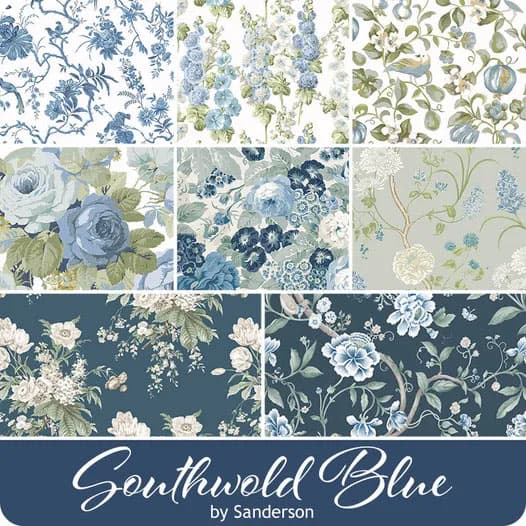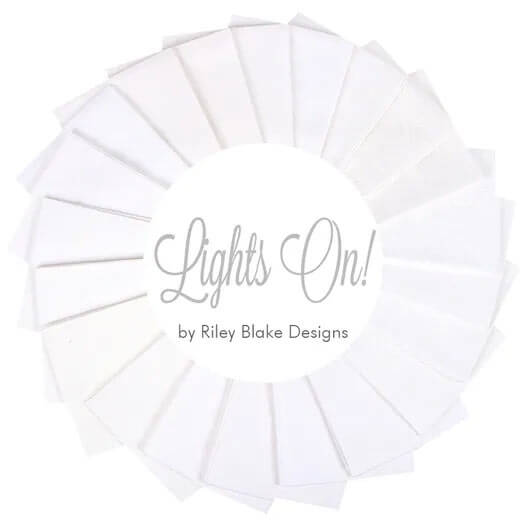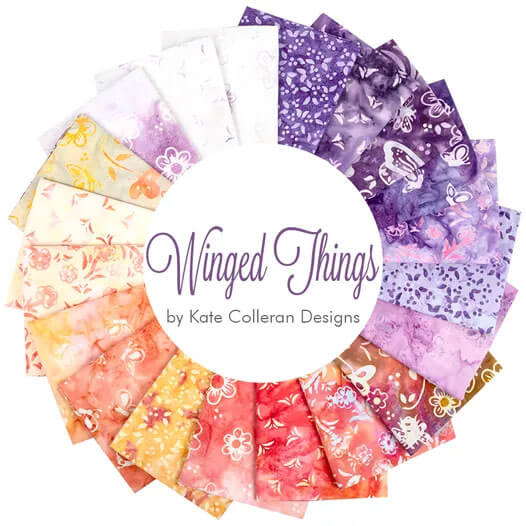- Home
- Free Quilt Block Patterns
- Four Crowns Quilt Block
Four Crowns Quilt Block
From our Free Quilt Block Patterns Library
This post contains affiliate links, for which I receive compensation.
Skill Level: Confident Beginner
The Four Crowns quilt block is easy to stitch when it's paper pieced.
Perfect points every time!
If you regularly cut your patches larger and then trim the units to the exact size after stitching, this technique will save you time, too.
There's much less trimming AND you create more accurate units at the same time. Sweet!
This block is closely related to the Union Square quilt block—all the same units are used. Just the fabric placement is reversed and then each border is flipped 180 degrees.
Let's get started on our Four Crowns block!
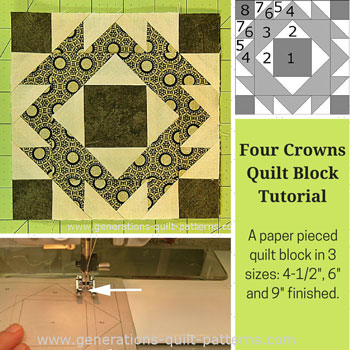
📋 General Instructions
These abbreviations are used on this page:
- SA - seam allowance
- RST - right sides together
SA are 1/4" unless otherwise noted.
When instructed to press, do it first with the sewn patches flat, just as they are sewn, then open the patch and press again, from the front this time.
Step 1: Download and print the pattern
You'll need the most current version of Adobe installed on your computer to download the pattern.
On the Adobe Print Menu page, under 'Page Size and Handling' set 'Custom Scale' to 100% before printing for accurate results. Click here to see what it looks like on the Print Menu page.
After printing, use the 1" square graphic on the printed pages to confirm they are printed accurately.
Choose the finished size of your Four Crowns. Click the link below to print.
Cut out the patterns just beyond the dashed lines.

Not sure which paper to use?
Take a look at my review of several of the most popular brands available to us quilters on the market.
You want a super-easy paper to tear away—less stress on the stitches.
The newest quilt fabrics to tickle your fancy...
Click the images below to see the full collection. We share any commercial and/or free patterns that showcase them, too. (For inspiration, of course!)
Step 2: Cutting Chart for a Four Crowns quilt block
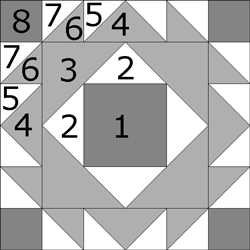 Four Crowns design
Four Crowns designSample Size: 6" finished / 6½" unfinished
Grid: 6x6
Attribution: KC Star
AKA: Effective Square (Ladies' Home Journal), Union (Ladies Art Company), Union Block (Nancy Cabot), Union Square (Carrie Hall and Rose Kretsinger)
Design Type: Uneven 9-patch large center
You'll need good contrast between your light, medium, and dark fabrics.
Choose small scale prints or fabrics that read as solids (or are solids) for the smaller half square triangles so that the points don't get lost.
With the exception of the first patch, all the rest are cut generously. Make a few blocks. Then, fine tune the patch sizes if it'll make piecing easier FOR YOU.
And finally, don't forget to subcut #2-7 (last column on the right—#4 is cut twice on the diagonal; the rest are cut once diagonally to form the necessary triangles for the sides units).
 |
Cutting Chart for a~ Paper Piecing ~ | |||||
|---|---|---|---|---|---|---|
| Patch | Fabric | Qty | Finished Block Size | Sub Cut | ||
| 4½" | 6” | 9” | ||||
| 1 | Dark | 1 | 2” x 2” | 2½" x 2½" | 3½" x 3½" | -- |
| 2 | Light | 2 | 2⅜" x 2⅜" | 2¾" x 2¾" | 3½" x 3½" | |
| 3 | Medium | 2 | 2⅞" x 2⅞" | 3⅜" x 3⅜" | 4⅜" x 4⅜" | |
| 4 | Medium | 1 | 3⅛" x 3⅛" | 3⅝" x 3⅝" | 4⅝" x 4⅝" | |
| 5, 7 | Light | 8 | 2⅛" x 2⅛" | 2⅜" x 2⅜" | 2⅞" x 2⅞" | |
| 6 | Medium | 4 | 2⅛" x 2⅛" | 2⅜" x 2⅜" | 2⅞" x 2⅞" | |
| 8 | Dark | 4 | 1¾" x 1¾" | 2” x 2” | 2½" x 2½" | -- |
| Unfinished Block Size | 5” | 6½" | 9½" | na | ||
| Grid Size | ¾" | 1” | 1½" | na | ||
Step 3: Assemble the Four Crowns units
General Sewing Machine Setup for Paperpiecing
- Reduce your stitch length to 16–20 stitches per inch (1.3-1.6 mm). This perforates the paper and stabilizes the seam when you remove the pattern. [Learn more about stitch length here.]
- Reduce your machine's speed or just plain slow down. Sew only as fast as you can stay on the stitching lines.
- Install an open toe appliqué foot (sometimes called an 'embroidery' or 'satin stitch' foot) if you have one (it's easier to see where you're stitching with one installed).
- Use a larger needle (90/14) if you have problems removing the pattern.
- If your machine has a needle stop up, use it. The stitching goes faster when you don't have to lift the presser foot with every seam.
- As you stitch each seam, start and stop a generous 1/4” before and after the solid stitching lines. ALWAYS. Future lines of stitching secure the ends.
After adding each patch, press the unit as it was sewn to set the seam and then open. The SA is automatically pressed towards the last patch added.
Before adding the next patch, take a look to make sure the one you just added covers the space plus seam allowance that it is supposed to.
Steam is optional and usually curls the pattern.
If that bothers you, don't use steam. Sometimes I do. Sometimes I don't.
It truly depends on my mood.
Remember, as you follow this paper piecing tutorial, the printed and the fabric sides of this block are mirror-images of each other.
At last!
Let's sew!
Center
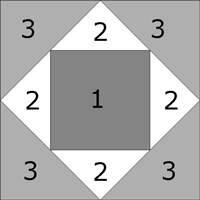
Make 1
Use some Elmer's Glue Stick to attach the #1 patch backside to the unprinted side of the pattern.
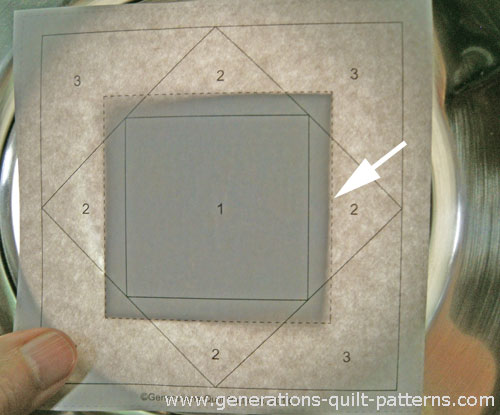 Dashed placement lines makes it easy!
Dashed placement lines makes it easy!With right sides together (RST) match the long edge of a #2 to #1.
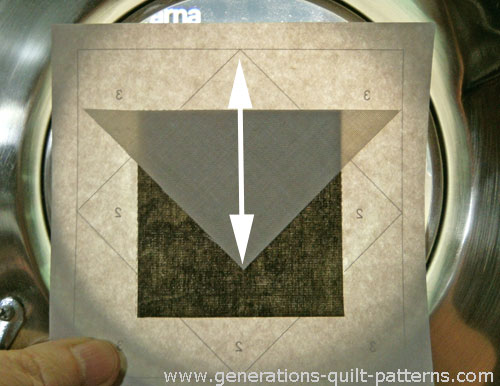 Placement Tip: The point of #2 should be directly opposite the corner of the patch on the pattern
Placement Tip: The point of #2 should be directly opposite the corner of the patch on the patternStitch, starting approximately a 1/4" before and ending a 1/4" after the solid line. (white arrows) Future lines of stitching secure these seams...just like in traditional piecing.
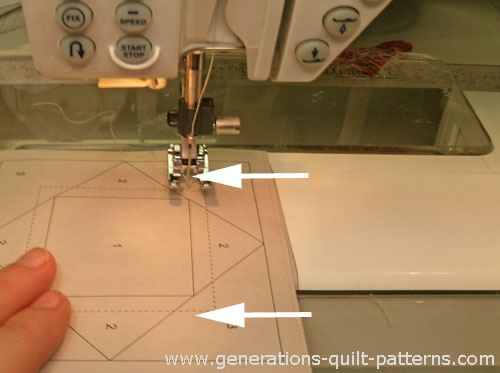
Repeat for the opposite #2. Press. (For the 4-1/2" block you may need to add/press each #2 individually because the pieces are so small.)
Add the remaining #2 in the same fashion.
Use a scissor to trim away any dog ears.
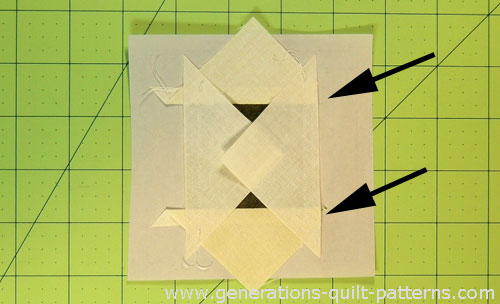 Dog ears are on the left side. After trimming on the right.
Dog ears are on the left side. After trimming on the right.After pressing, it's time to trim to establish the next placement lines.
To do this, lay the unit printed side up on your cutting mat. Lay the edge of the ruler directly on the sewing line between the #2 and #3 patches.
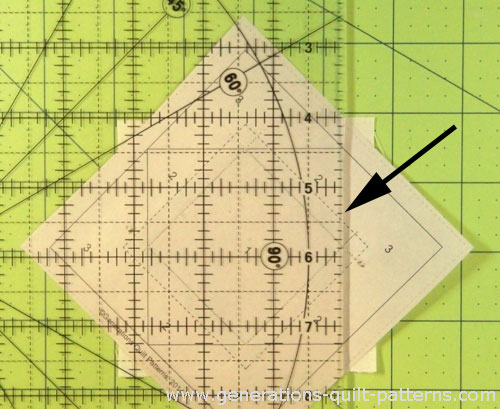
Crease the paper with your fingernail along the line.
Lift the ruler and fold back the paper. You need to pull the pattern away from the stitches.
Replace the ruler, this time with the 1/4" marking on the folded edge of the pattern. Trim away the excess fabric.
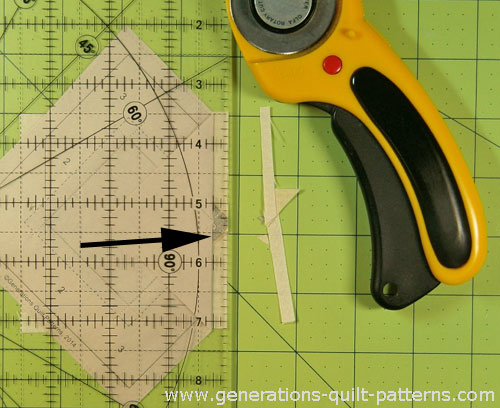 The arrow points to the 1/4" line.
The arrow points to the 1/4" line.Repeat for the remaining three sides.
Next position the long edge of a #3 with the freshly cut edge of the #2s.
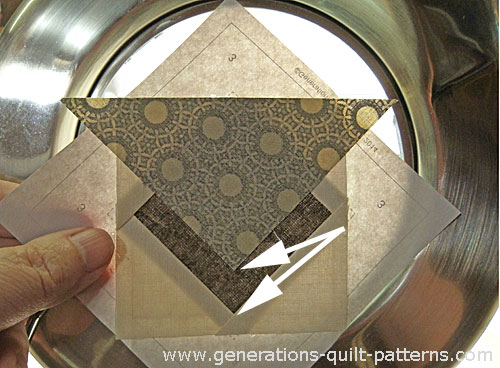 Placement Tip: The point of #3 should line up with the corner of patch #1
Placement Tip: The point of #3 should line up with the corner of patch #1Stitch.
Add the opposite #3. Press.
Add the final two #3 in the same manner.
After pressing, we'll trim the block to the needed size.
With the printed side up on your cutting mat, place the 1/4" line of your ruler on the solid black outline around the perimeter of this unit. Trim. Repeat for the remaining sides.
This is the perfect center for our Four Crowns quilt block.

Borders


Make 2 short and 2 long
Use a bit of your glue stick adhere the back side of a #4 in position on the unprinted side of each of the four border patterns between the placement guides.
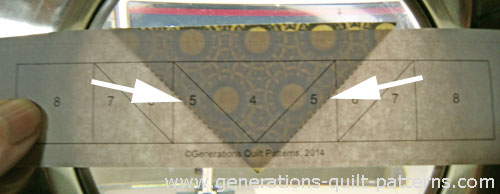 Arrows point to the dashed placement lines.
Arrows point to the dashed placement lines.With RST, match the long edge of a #5 to #4.
When the point of the #5 is opposite the corner on the pattern (white arrow) your patch is in perfect position.
To prevent the darker #4's SA from shadowing through to the top, nudge the cut edge of #5 just an teeny-tiny bit past the cut edge of the #4 (black arrow).
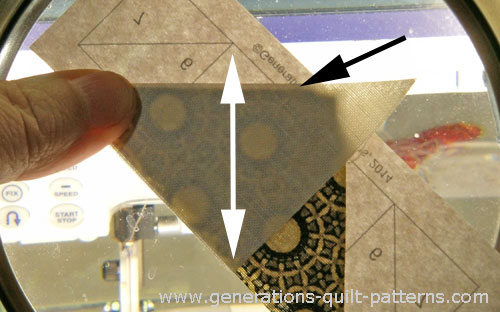
Stitch and repeat for the second #5. Press.
Trim the seam allowance of the #5s just like you did for the #2 patches in the center.
Add the #6s and #7s to all four border units, and then the #8s to the two longer borders, pressing and trimming seam allowances as you go.
After all the sewing is complete, then trim the units to size by placing the 1/4" line of your ruler on the solid black line at the edge of the block. Trim with your rotary cutter. Repeat for all sides.

The paper piecing is complete. From this point forward, return your stitch length to the one you regularly use for piecing and install your favorite 1/4" presser foot.
Step 4: Assemble the Four Crowns quilt block
Arrange the sewn units into rows. Make sure that all the points in the borders point to the outside edge of the blocks.
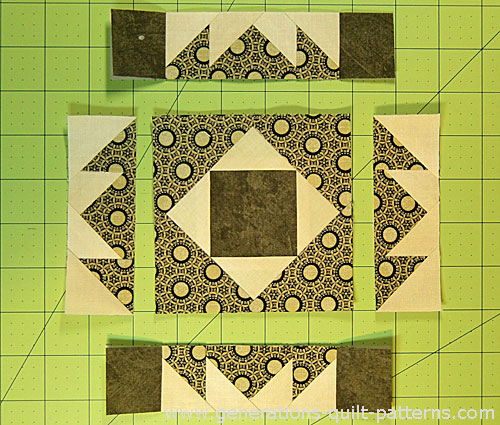
With RST, stitch the short borders to the left and right side of the center. Press the SA toward the center. Pinning helps keep the cut edges even as you sew.
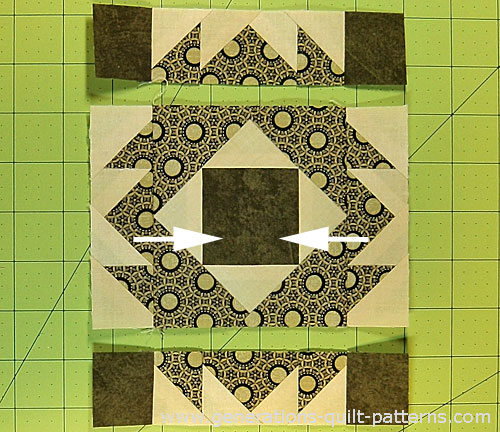
With RST, stitch the rows together. Use pins to help match the seams.
With all the pointy action going on in our Four Crowns, the seams can get rather lumpy. Try our favorite pressing technique for amazingly flat blocks. It's really simple.
Promise!
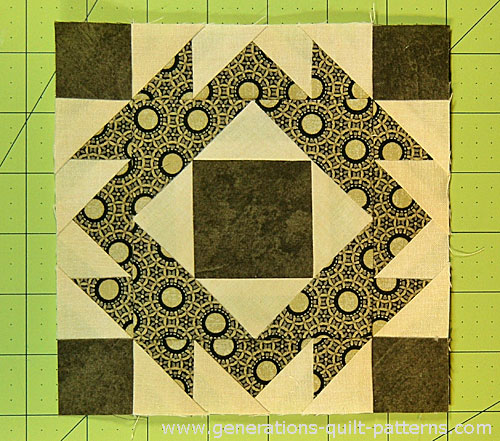 Four Crowns quilt block
Four Crowns quilt blockYour Four Crowns quilt block is complete!
What about a different quilt block?
For a list of all the 220+ quilt block patterns on this site, start here.
If you know the name of the block, shorten your search by using these links:
Click here if you're looking for blocks with at least some paper piecing.
Click here if you're looking for the basic building blocks of quilting, i.e., Flying Geese, half square triangles, quarter square triangles, etc., along with several techniques to make each.
And finally, use these links to find blocks in these finished sizes:
